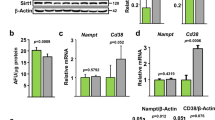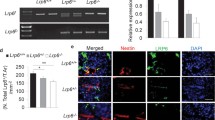Abstract
Wnt signaling is vital for osteoblast differentiation and recently has been associated with aging. Because impaired osteoblastogenesis is a cellular characteristic of age-induced bone loss, we investigated whether this process is associated with an altered expression of Wnt signaling-related proteins in bone and osteoblasts. Bone marrow cells were isolated from male C57BL/6 mice, aged 6 weeks, 6 months, and 18 months, respectively. Osteogenic differentiation was induced for 3 weeks and assessed using alizarin red staining. Gene expression of Wnt1, 3a, 4, 5a, 5b, 7b, 9b, 10b, lipoprotein receptor-related protein (LRP)-5/6, as well as dickkopf-1 (Dkk-1), sclerostin, and secreted frizzled related protein-1 (sFRP-1) was determined in bone tissue and osteoblasts on days 7, 14, and 21 by real-time RT-PCR. Osteoblast differentiation was significantly reduced in aged mice compared with young and adult mice. In bone tissue, expression levels of all genes assessed were decreased in adult and old mice, respectively, compared with young mice. Mature osteoblasts of aged compared with those of young mice showed enhanced expression of Wnt9b, LRP-6, and Dkk-1, and decreased expression of Wnt5a and 7b. In early osteoblasts, mRNA levels of Wnt1, 5a, 5b, and 7b were increased significantly in aged mice. The expression of Wnt3a, 4, LRP-5, and sclerostin was not altered in aged osteoblasts. In conclusion, osteoblastic expression of each Wnt-related protein is regulated individually by aging. The overall decreased expression of Wnt-related proteins in bone tissue of aged mice underlines the newly discovered association of Wnt signaling with aging.






Similar content being viewed by others
References
Baksh D, Tuan RS (2007) Canonical and non-canonical Wnts differentially affect the development potential of primary isolate of human bone marrow mesenchymal stem cells. J Cell Physiol 212:817–826
Bennett CN, Longo KA, Wright WS, Suva LJ, Lane TF, Hankenson KD, MacDougall OA (2005) Regulation of osteoblastogenesis and bone mass by Wnt10b. Proc Natl Acad Sci USA 102:3324–3329
Bodine PV, Billiard J, Moran RA, Ponce-de-Leon H, McLarney S, Mangine A, Scrimo MJ, Bhat RA, Stauffer B, Green J, Stein GS, Lian JB, Komm BS (2005) The Wnt antagonist secreted frizzled-related protein-1 controls osteoblast and osteocyte apoptosis. J Cell Biochem 96:1212–1230
Boland GM, Perkins G, Hall DJ, Tuan RS (2004) Wnt 3a promotes proliferation and suppresses osteogenic differentiation of adult human mesenchymal stem cells. J Cell Biochem 93:1210–1230
Brack AS, Conboy MJ, Roy S, Lee M, Kuo CJ, Keller C, Rando TA (2007) Increased Wnt signaling during aging alters muscle stem cell fate and increases fibrosis. Science 317:807–810
Cho SW, Her SJ, Sun HJ, Choi OK, Yang JY, Kim SW, Kim SY, Shin CS (2008) Differential effects of secreted frizzled-related proteins (sFRPs) on osteoblastic differentiation of mouse mesenchymal cells and apoptosis of osteoblasts. Biochem Biophys Res Commun 367:399–405
Clarke BL, Ebeling PR, Jones JD, Wahner HW, O’Fallon WM, Riggs BL, Fitzpatrick AL (1996) Changes in quantitative bone histomorphometry in aging healthy men. J Clin Endocrinol Metab 81:2264–2270
de Boer J, Siddappa R, Gaspar C, van Apeldoorn A, Fodde R, van Blitterswijk C (2004) Wnt signaling inhibits osteogenic differentiation of human mesenchymal stem cells. Bone 34:818–826
Decarolis NA, Wharton KA, Eisch AJ (2008) Which way does the Wnt blow? Exploring the duality of canonical Wnt signaling on cellular aging. Bioessays 30:102–106
Kang S, Bennett CN, Gerin I, Rapp LA, Hankenson KD, Macdougald OA (2007) Wnt signaling stimulates osteoblastogenesis of mesenchymal precursors by suppressing CCAAT/enhancer-binding protein alpha and peroxisome proliferator-activated receptor gamma. J Biol Chem 282:14515–14524
Krishnan V, Bryant HU, Macdougald OA (2006) Regulation of bone mass by Wnt signaling. J Clin Invest 116:1202–1209
Liu H, Fergusson MM, Castilho RM, Liu J, Cao L, Chen J, Malide D, Rovira II, Schimel D, Kuo CJ, Gutkind JS, Hwang PM, Finkel T (2007) Augmented Wnt signaling in a mammalian model of accelerated aging. Science 317:803–806
Morvan F, Boulukos K, Clément-Lacroix P, Roman Roman S, Suc-Royer I, Vayssière B, Ammann P, Martin P, Pinho S, Pognonec P, Mollat P, Niehrs C, Baron R, Rawadi G (2006) Deletion of a single allele of the Dkk1 gene leads to an increase in bone formation and bone mass. J Bone Miner Res 21:934–945
Nakanishi R, Shimizu M, Mori M, Akiyama H, Okudaira S, Otsuki B, Hashimoto M, Higuchi K, Hosokawa M, Tsuboyama T, Nakamura T (2006) Secreted frizzled-related protein 4 is a negative regulator of peak BMD in SAMP6 mice. J Bone Miner Res 21:1713–1721
Parfitt AM (1979) Quantum concept of bone remodelling and turnover: implications for the pathogenesis of osteoporosis. Calcif Tissue Int 28:1–5
Parfitt AM, Villanueva AR, Foldes J, Rao DS (1995) Relations between histologic indices of bone formation: implications for the pathogenesis of spinal osteoporosis. J Bone Miner Res 10:466–473
Pietschmann P, Skalicky M, Kneissel M, Rauner M, Hofbauer G, Stupphann D, Viidik A (2007) Bone structure and metabolism in a rodent model of male senile osteoporosis. Exp Gerontol 42:1099–1108
Poole KE, van Bezooijen RL, Loveridge N, Hamersma H, Papapoulos SE, Löwik CW, Reeve J (2005) Sclerostin is a delayed secreted product of osteocytes that inhibits bone formation. FASEB J 19:1842–1844
Rauner M, Winzer M, Stupphann D, Krenbek D, Pietschmann P (2007) RANKL and OPG gene expression bone marrow stromal cells and calvarial osteoblasts in mouse and rat. Osteologie 16:19–28
Si W, Kang Q, Luu HH, Park JK, Luo Q, Song WX, Jiang W, Luo X, Li X, Yin H, Montag AG, Haydon RC, He TC (2006) CCN1/Cyr61 is regulated by the canonical Wnt signal and plays an important role in Wnt3A-induced osteoblast differentiation of mesenchymal stem cells. Mol Cell Biol 26:2955–2964
Sipos W, Pietschmann P, Rauner M (2008) Strategies for novel therapeutic approaches targeting cytokines and signaling pathways of osteoclasto- and osteoblastogenesis in the fight against immune-mediated bone and joint diseases. Curr Med Chem 15:127–136
Takada I, Mihara M, Suzawa M, Ohtake F, Kobayashi S, Igarashi M, Youn MY, Takeyama K, Nakamura T, Mezaki Y, Takezawa S, Yogiashi Y, Kitagawa H, Yamada G, Takada S, Minami Y, Shibuya H, Matsumoto K, Kato S (2007) A histone lysine methyltransferase activated by non-canonical Wnt signalling suppresses PPAR-gamma transactivation. Nat Cell Biol 9:1273–1285
van der Horst G, van der Werf SM, Farih-Sips H, van Bezooijen RL, Löwik CW, Karperien M (2005) Downregulation of Wnt signaling by increased expression of Dickkopf-1 and −2 is a prerequisite for late-stage osteoblast differentiation of KS483 cells. J Bone Miner Res 20:1867–1877
Vertino AM, Taylor-Jones JM, Longo KA, Bearden ED, Lane TF, McGehee RE, MacDougald OA, Peterson CA (2005) Wnt10b deficiency promotes coexpression of myogenic and adipogenic programs in myoblasts. Mol Biol Cell 16:2039–2048
Wang FS, Lin CL, Chen YJ, Wang CJ, Yang KD, Huang YT, Sun YC, Huang HC (2005) Secreted frizzled-related protein 1 modulates glucocorticoid attenuation of osteogenic activities and bone mass. Endocrinology 146:2415–2423
WHO Study Group (1994) Osteoporosis Working Group. WHO Technical Report Services 843:6
Winkler DG, Sutherland MK, Geoghegan JC, Yu C, Hayes T, Skonier JE, Shpektor D, Jonas M, Kovacevich BR, Staehling-Hampton K, Appleby M, Brunkow ME, Latham JA (2003) Osteocyte control of bone formation via sclerostin, a novel BMP antagonist. EMBO J 22:6267–6276
Zhou S, Greenberger JS, Epperly MW, Goff JP, Adler C, Leboff MS, Glowacki J (2008) Age-related intrinsic changes in human bone marrow-derived mesenchymal stem cells and their differentiation to osteoblasts. Aging Cell 7:335–343
Acknowledgements
This work was supported by the Ludwig Boltzmann Institute of Aging Research, Vienna, Austria and the Austrian Science Fund (project number P20239).
Author information
Authors and Affiliations
Corresponding author
About this article
Cite this article
Rauner, M., Sipos, W. & Pietschmann, P. Age-dependent Wnt gene expression in bone and during the course of osteoblast differentiation. AGE 30, 273–282 (2008). https://doi.org/10.1007/s11357-008-9069-9
Received:
Accepted:
Published:
Issue Date:
DOI: https://doi.org/10.1007/s11357-008-9069-9




